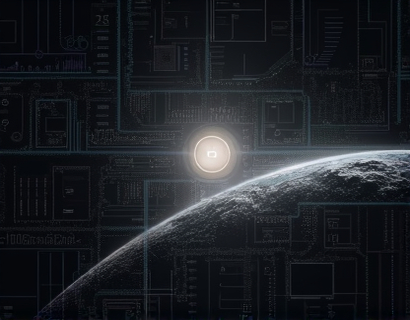Decentralized Innovation: Transforming Global Blockchain Collaboration Through Comprehensive Platforms
The advent of blockchain technology has ushered in a new era of decentralized systems, promising transparency, security, and efficiency in various sectors. At the heart of this revolution is the need for robust platforms that can enhance collaboration, innovation, and governance within decentralized networks. This article delves into a transformative platform designed to revolutionize how global blockchain communities operate, offering a comprehensive guide for enthusiasts and innovators aiming to drive efficiency and scalability in distributed networks.
The core challenge in decentralized systems is the lack of centralized control, which can lead to fragmented efforts and inefficient resource allocation. Traditional blockchain projects often struggle with coordination among diverse stakeholders, including developers, investors, and users. To address these challenges, a new generation of platforms is emerging, focusing on creating integrated ecosystems that streamline collaboration and decision-making processes. These platforms leverage advanced blockchain features such as smart contracts, decentralized governance, and token economics to foster a more cohesive and dynamic community.
One of the key features of this transformative platform is its decentralized governance model. Unlike conventional top-down approaches, decentralized governance empowers community members to participate in decision-making through voting mechanisms. This ensures that the development and direction of the platform are aligned with the collective interests of its users. The platform employs a token-based system where participants can stake tokens to vote on proposals, ensuring that those with a vested interest in the network's success have a say in its evolution. This democratic approach not only enhances transparency but also builds trust among users, encouraging greater engagement and contribution.
Another critical aspect of the platform is its focus on comprehensive collaboration tools. In the decentralized space, collaboration is often hindered by the lack of integrated tools and platforms that can facilitate seamless communication and resource sharing. The platform addresses this by providing a suite of tools designed to support various stages of project development, from ideation to execution. These tools include decentralized project management boards, collaborative coding environments, and community forums. By centralizing these resources on a single platform, users can more easily connect with like-minded individuals, share knowledge, and work together on innovative projects.
Innovation is a cornerstone of the blockchain ecosystem, and this platform recognizes the importance of fostering a culture of creativity and experimentation. To support this, the platform offers a sandbox environment where developers can test new ideas and prototypes without the risk of disrupting the main network. This sandbox is equipped with pre-built templates and tools that simplify the development process, allowing innovators to focus on refining their concepts. Additionally, the platform hosts regular hackathons and challenges, incentivizing participants with token rewards for groundbreaking solutions. These events not only drive innovation but also build a sense of community and competition among users.
Scalability is another critical factor in the success of decentralized networks. As the number of users and transactions grows, traditional blockchain architectures often struggle to maintain performance and efficiency. The transformative platform tackles this issue by integrating advanced scalability solutions such as sharding and layer 2 protocols. Sharding involves dividing the blockchain into smaller, more manageable pieces, each handling a subset of transactions. This not only increases throughput but also reduces congestion on the main chain. Layer 2 solutions, such as state channels and sidechains, further enhance scalability by processing transactions off the main blockchain and settling them in batches. These technologies ensure that the platform can handle high volumes of activity without compromising on security or decentralization.
To ensure the platform remains accessible and user-friendly, a strong emphasis is placed on developer-friendly tools and documentation. The platform provides a comprehensive API suite that allows developers to build custom applications and integrations with minimal effort. Detailed documentation, tutorials, and community support are available to help newcomers get started and advanced users optimize their projects. This focus on accessibility helps to lower the barriers to entry, encouraging a broader range of participants to contribute to the ecosystem.
Security is paramount in any blockchain platform, and this transformative solution does not compromise on this aspect. The platform employs a multi-layered security approach, combining traditional cryptographic techniques with decentralized consensus mechanisms. Smart contracts are rigorously audited by third-party security firms to identify and mitigate vulnerabilities. Additionally, the platform implements real-time monitoring and anomaly detection systems to quickly identify and respond to potential security threats. By prioritizing security, the platform builds confidence among users and ensures the integrity of the decentralized network.
The platform also recognizes the importance of interoperability in the blockchain landscape. As various blockchain networks develop in isolation, the potential for fragmented ecosystems increases. To combat this, the platform supports cross-chain communication and asset transfer through standardized protocols and bridges. This interoperability allows users to seamlessly move assets and data between different blockchain networks, fostering a more connected and cohesive decentralized world. By breaking down silos, the platform enhances the overall utility and value of the blockchain ecosystem.
In terms of economic incentives, the platform employs a token economy designed to align the interests of all stakeholders. Tokens are used not only for governance voting but also as a utility token for accessing platform services and participating in reward programs. The token economy is carefully balanced to prevent centralization, with mechanisms in place to distribute tokens fairly among contributors. This ensures that the platform remains decentralized and that no single entity can dominate the network. The token can be earned through various activities such as contributing code, participating in governance, and engaging in community events, creating a virtuous cycle of participation and reward.
To further enhance the user experience, the platform incorporates advanced user interface and experience (UI/UX) design principles. The dashboard is intuitive and visually appealing, providing users with real-time insights into network activity, project progress, and personal token balances. Customizable dashboards allow users to focus on the metrics and information most relevant to their interests. Mobile responsiveness ensures that the platform is accessible on various devices, making it convenient for users to stay connected and engaged regardless of their location.
Education and community building are integral components of the platform's mission. The platform offers a robust educational resource center featuring tutorials, webinars, and articles covering a wide range of blockchain topics. From beginner-friendly guides to advanced technical deep dives, the educational content is designed to cater to users at all skill levels. Regular community meetups, both online and offline, provide opportunities for users to network, share experiences, and collaborate on projects. These events help to build a strong, supportive community that drives collective growth and innovation.
The impact of this transformative platform extends beyond the immediate benefits to its users. By enhancing collaboration, innovation, and governance in decentralized networks, the platform contributes to the overall advancement of blockchain technology. It sets a new standard for how decentralized platforms can operate, demonstrating that with the right tools and governance models, decentralized systems can achieve greater efficiency and scalability. As more projects and communities adopt similar approaches, the blockchain ecosystem as a whole becomes more robust, resilient, and capable of addressing complex global challenges.
In conclusion, the transformative platform represents a significant leap forward in decentralized innovation. By addressing key challenges such as governance, collaboration, scalability, and security, it provides a comprehensive solution for blockchain enthusiasts and innovators. The platform's focus on user empowerment, economic incentives, and community building ensures that it remains a dynamic and inclusive ecosystem. As the blockchain landscape continues to evolve, platforms like this will play a crucial role in shaping the future of decentralized networks, driving global efficiency, and unlocking new possibilities for innovation.











































